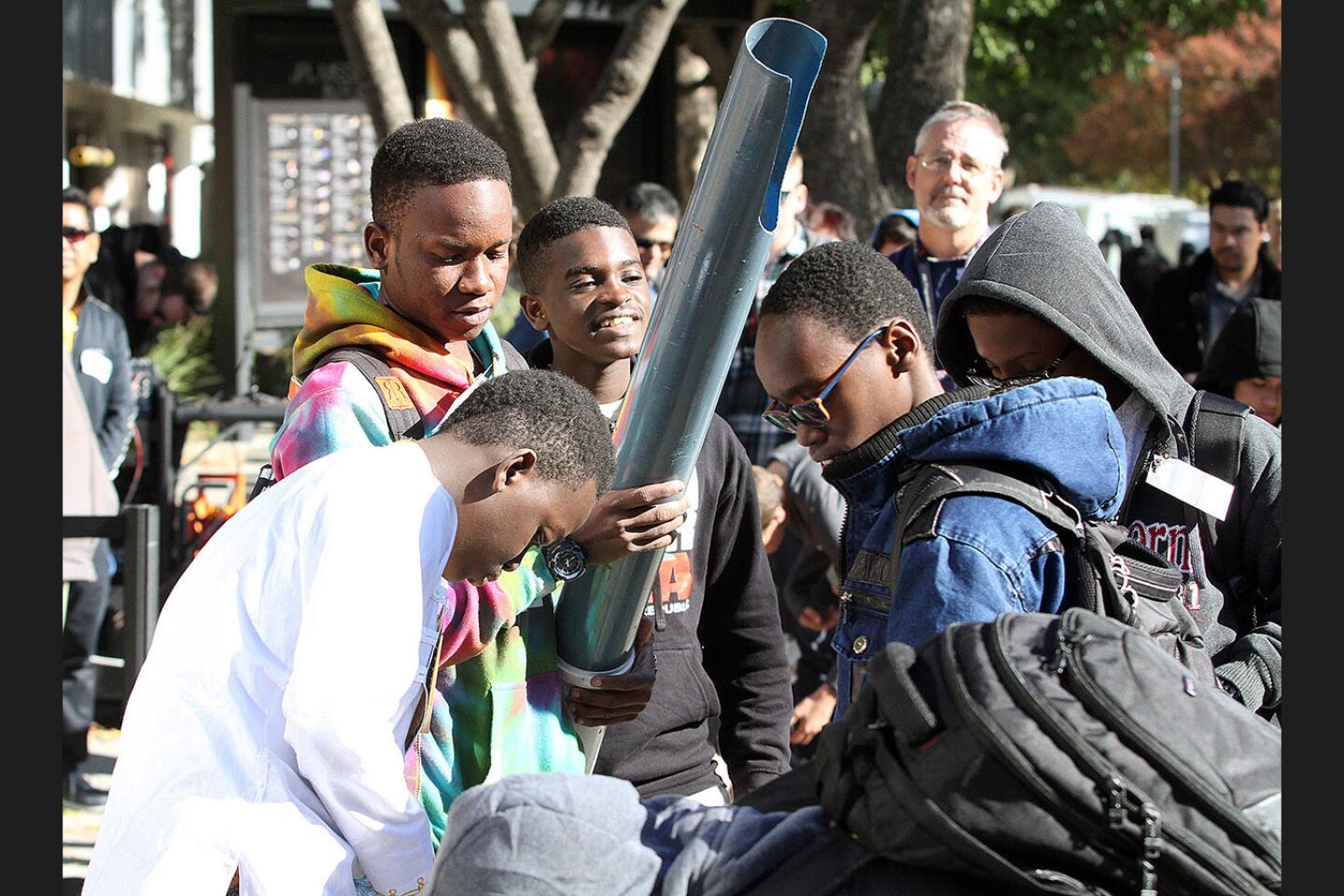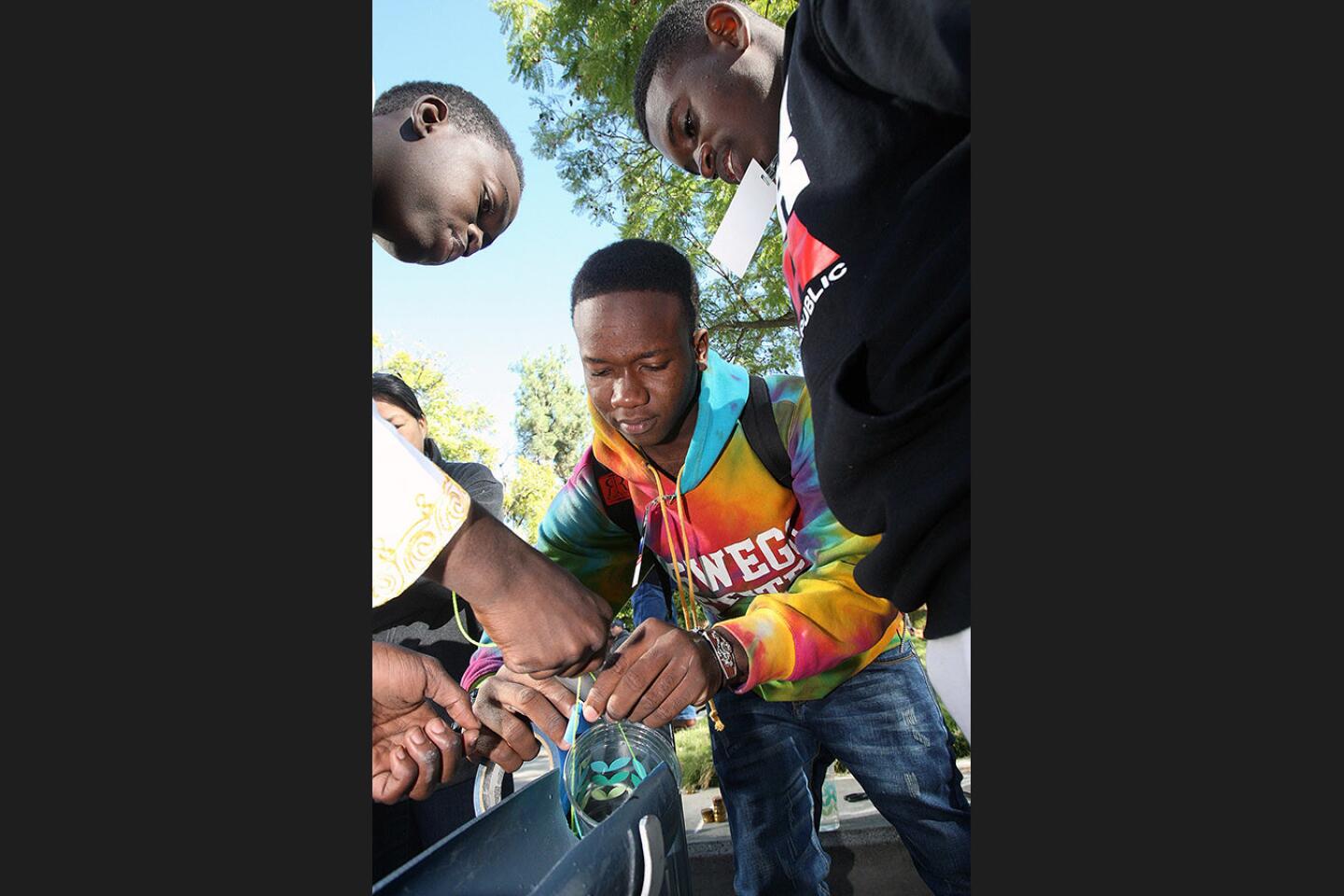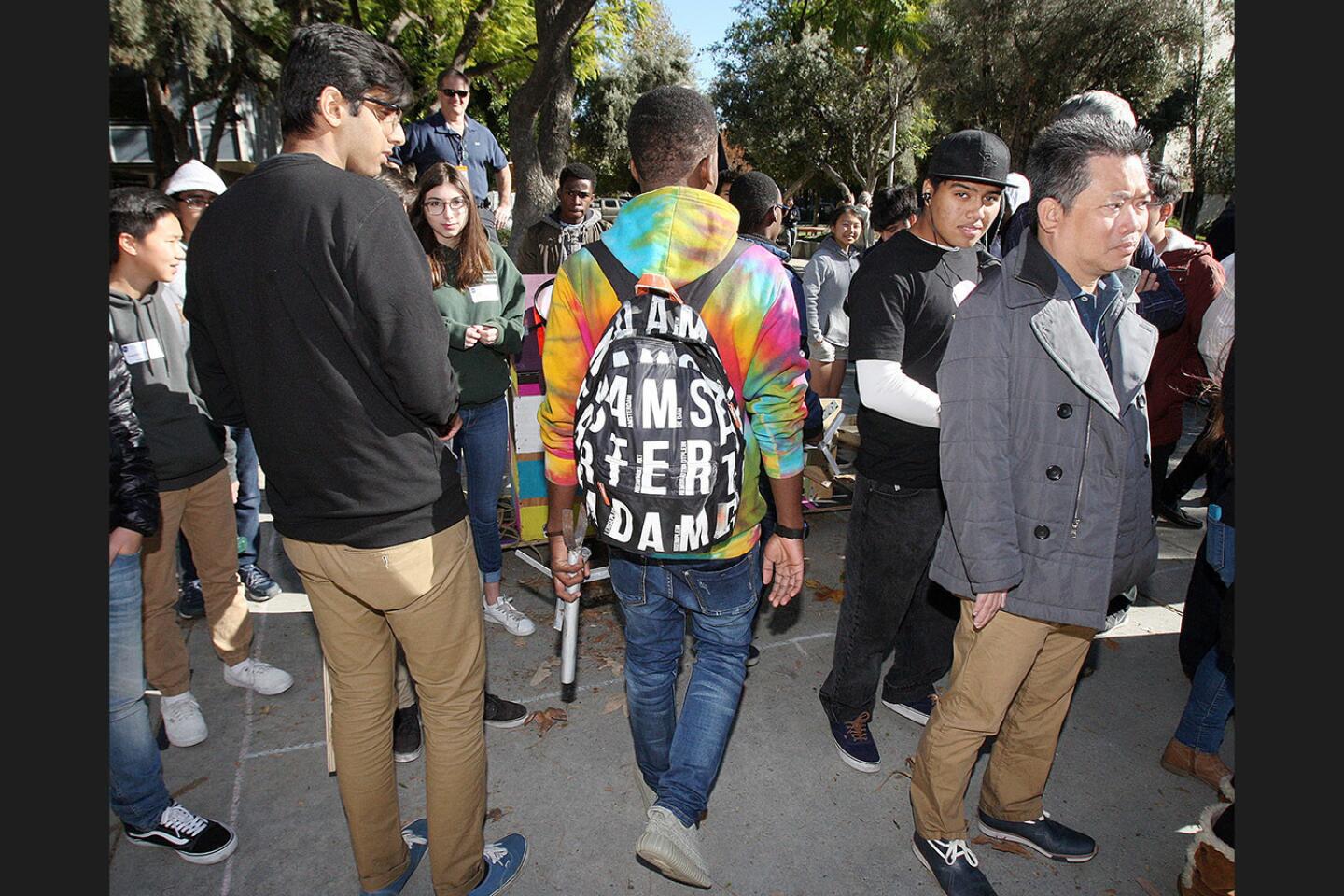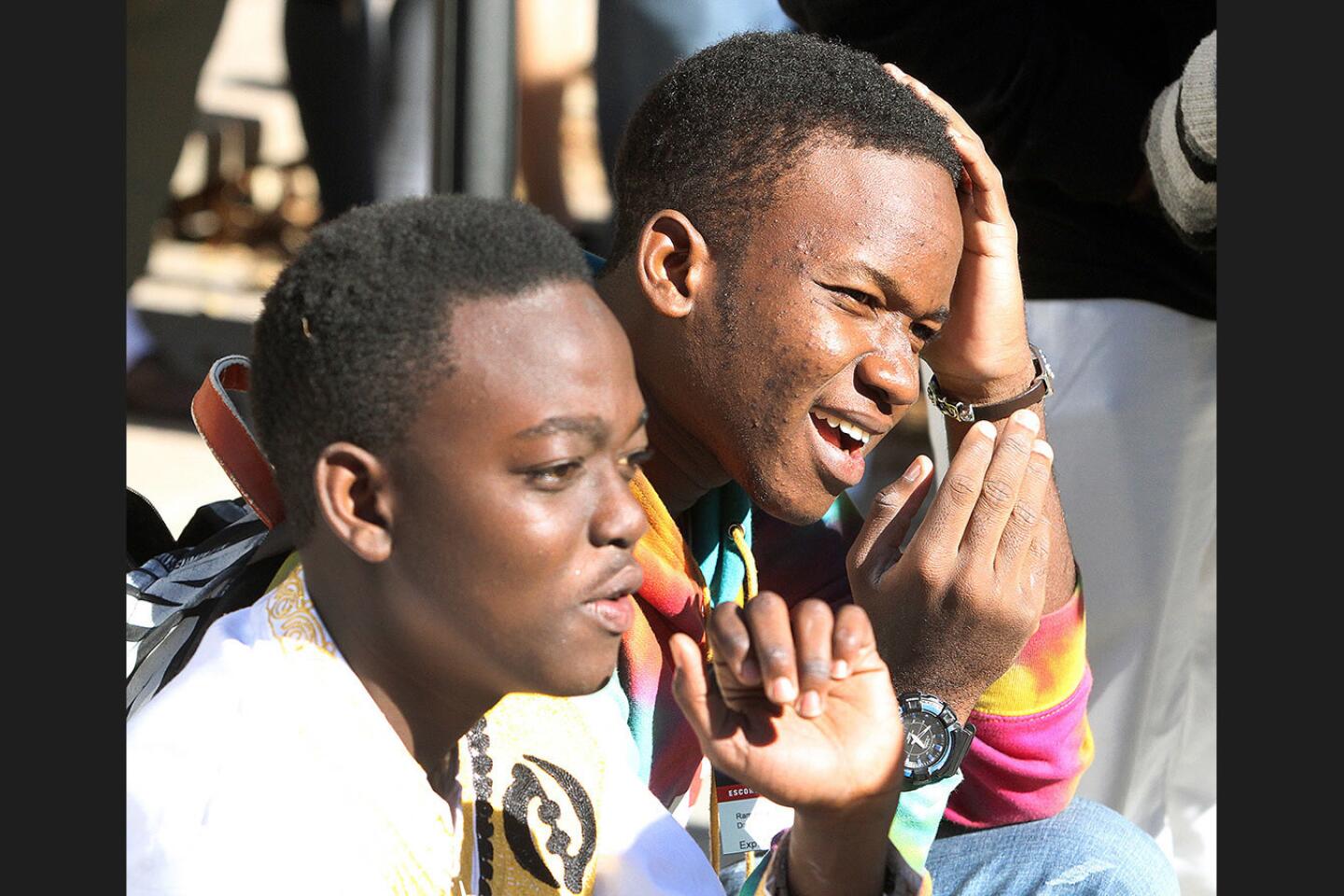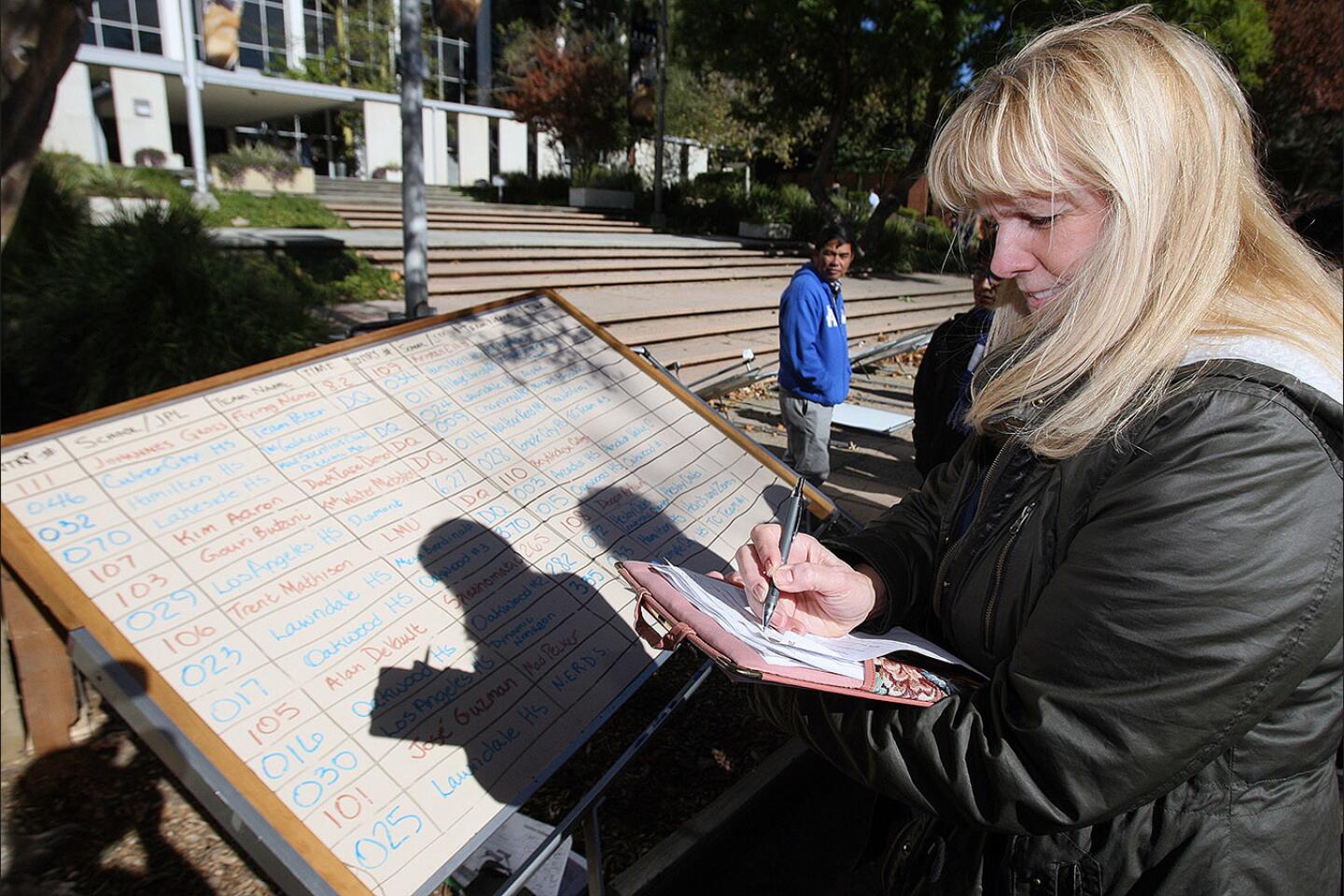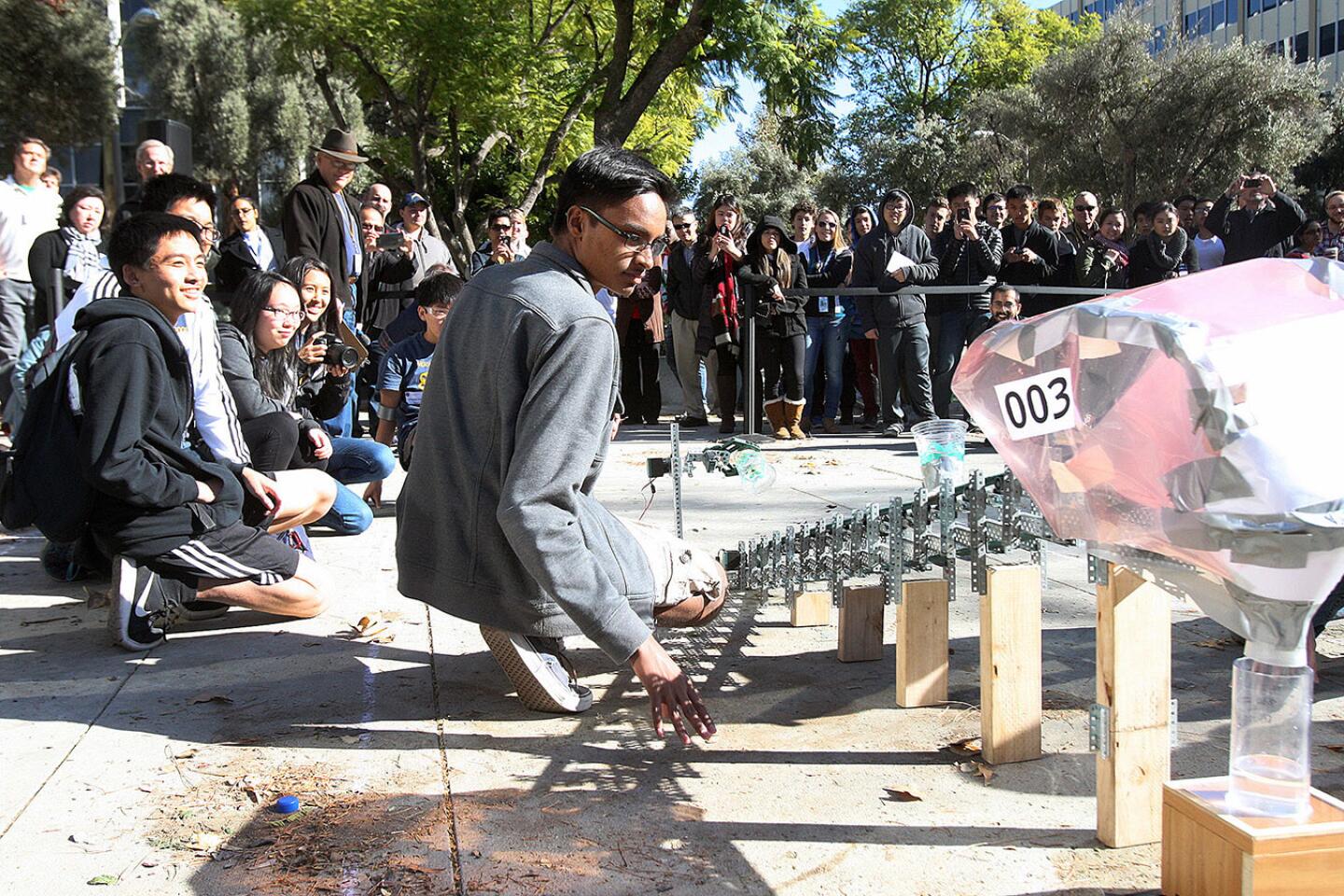For 19 years, the “JPL Invention Challenge” at NASA’s Jet Propulsion Laboratory has pitted students against staff members in a contest to see who can design a device or process for completing a specified challenge in the most efficient manner.
More than 75 competitors accepted this year’s “Don’t Waste a Drop” challenge — to create an apparatus capable of conveying 250 grams of water and one 3-D printed goldfish to a second device at least 6 feet away — and on Friday morning, 27 regional finalists faced off for a winning trophy and serious bragging rights.
But, in a break with tradition, a 28th team was allowed to compete.
Join the conversation on Facebook >>
1/19
The team from Tanzania brings their invention into the competitor’s square at JPL’s annual Invention Challenge on Friday, December 2, 2016. 28 teams, including a team from Tanzania, but mostly of local Southern California schools, competed. The challenge was to transfer a specific amount of water over a distance to a collection cup on the other side. Methods included catapults, conveyor belts, a lot of duct tape, and pvc. (Tim Berger / Staff Photographer)
2/19
Ramadhan Daud, with help from his team, ties a string around a cup for a first-time test of their invention at JPL’s annual Invention Challenge on Friday, December 2, 2016. 28 teams, including a team from Tanzania, but mostly of local Southern California schools, competed. The challenge was to transfer a specific amount of water over a distance to a collection cup on the other side. Methods included catapults, conveyor belts, a lot of duct tape, and pvc. (Tim Berger / Staff Photographer)
3/19
JPL scientist Paul Backes talks with Francis Msuya, of Tanzania, as the rest of the team tries to get their invention to work at JPL’s annual Invention Challenge on Friday, December 2, 2016. 28 teams, including a team from Tanzania, but mostly of local Southern California schools, competed. The challenge was to transfer a specific amount of water over a distance to a collection cup on the other side. Methods included catapults, conveyor belts, a lot of duct tape, and pvc. (Tim Berger / Staff Photographer)
4/19
The Tanzanian team, including Raphael Ngonyani, Salim Mauled,a nd Ramadhan Daud, tie a string together to do a first-time test of their invention with a cup, something they didn’t have at home, at JPL’s annual Invention Challenge on Friday, December 2, 2016. 28 teams, including a team from Tanzania, but mostly of local Southern California schools, competed. The challenge was to transfer a specific amount of water over a distance to a collection cup on the other side. Methods included catapults, conveyor belts, a lot of duct tape, and pvc. (Tim Berger / Staff Photographer)
5/19
After the Tanzanian team’s invention fails to pour the cup of water into the transfer chute they created, team advisor Dogan Aykurt consoles team leader Ramadhan Daud who is dejected, but tries to keep a smile, at JPL’s annual Invention Challenge on Friday, December 2, 2016. 28 teams, including a team from Tanzania, but mostly of local Southern California schools, competed. The challenge was to transfer a specific amount of water over a distance to a collection cup on the other side. Methods included catapults, conveyor belts, a lot of duct tape, and pvc. (Tim Berger / Staff Photographer)
6/19
Francis Msuya, and Alfred Woiso, of Tanzania, put their invention back in the suitcase they travelled with to compete at JPL’s annual Invention Challenge on Friday, December 2, 2016. 28 teams, including a team from Tanzania, but mostly of local Southern California schools, competed. The challenge was to transfer a specific amount of water over a distance to a collection cup on the other side. Methods included catapults, conveyor belts, a lot of duct tape, and pvc. (Tim Berger / Staff Photographer)
7/19
JPL’s Paul Backes help the Tanzania team with the design of their invention at JPL’s annual Invention Challenge on Friday, December 2, 2016. 28 teams, including a team from Tanzania, but mostly of local Southern California schools, competed. The challenge was to transfer a specific amount of water over a distance to a collection cup on the other side. Methods included catapults, conveyor belts, a lot of duct tape, and pvc. (Tim Berger / Staff Photographer)
8/19
The Tanzanian team at JPL’s annual Invention Challenge on Friday, December 2, 2016. 28 teams, including a team from Tanzania, but mostly of local Southern California schools, competed. The challenge was to transfer a specific amount of water over a distance to a collection cup on the other side. Methods included catapults, conveyor belts, a lot of duct tape, and pvc. (Tim Berger / Staff Photographer)
9/19
Ramadhan Daud, of Tanzania, leaves the competitor’s circle through other teams and parents who are about to compete at JPL’s annual Invention Challenge on Friday, December 2, 2016. 28 teams, including a team from Tanzania, but mostly of local Southern California schools, competed. The challenge was to transfer a specific amount of water over a distance to a collection cup on the other side. Methods included catapults, conveyor belts, a lot of duct tape, and pvc. (Tim Berger / Staff Photographer)
10/19
Team leader Ramadhan Daud, with teammate Salim Mauled, looks up after having his head in his hands with trepidation before his team’s invention is put to the test at JPL’s annual Invention Challenge on Friday, December 2, 2016. 28 teams, including a team from Tanzania, but mostly of local Southern California schools, competed. The challenge was to transfer a specific amount of water over a distance to a collection cup on the other side. Methods included catapults, conveyor belts, a lot of duct tape, and pvc. (Tim Berger / Staff Photographer)
11/19
Tanzania team advisor Dogan Aykurt helps to set up his team’s invention at JPL’s annual Invention Challenge on Friday, December 2, 2016. 28 teams, including a team from Tanzania, but mostly of local Southern California schools, competed. The challenge was to transfer a specific amount of water over a distance to a collection cup on the other side. Methods included catapults, conveyor belts, a lot of duct tape, and pvc. (Tim Berger / Staff Photographer)
12/19
A ring of parents and contestants watch other water transfer inventions at JPL’s annual Invention Challenge on Friday, December 2, 2016. 28 teams, including a team from Tanzania, but mostly of local Southern California schools, competed. The challenge was to transfer a specific amount of water over a distance to a collection cup on the other side. Methods included catapults, conveyor belts, a lot of duct tape, and pvc. (Tim Berger / Staff Photographer)
13/19
JPL’s Sherry Stukes, of Ground Data Systems coordinates the data she receives with the score board in front of her at JPL’s annual Invention Challenge on Friday, December 2, 2016. 28 teams, including a team from Tanzania, but mostly of local Southern California schools, competed. The challenge was to transfer a specific amount of water over a distance to a collection cup on the other side. Methods included catapults, conveyor belts, a lot of duct tape, and pvc. (Tim Berger / Staff Photographer)
14/19
JPL’s referee Chris Landry, Structural Engineering, closely watches water drop into a vessel at JPL’s annual Invention Challenge on Friday, December 2, 2016. 28 teams, including a team from Tanzania, but mostly of local Southern California schools, competed. The challenge was to transfer a specific amount of water over a distance to a collection cup on the other side. Methods included catapults, conveyor belts, a lot of duct tape, and pvc. (Tim Berger / Staff Photographer)
15/19
Alan DeVault, of Pasadena, watches his catapult start to move a cup of water to be dropped into a collection cup at JPL’s annual Invention Challenge on Friday, December 2, 2016. 28 teams, including a team from Tanzania, but mostly of local Southern California schools, competed. The challenge was to transfer a specific amount of water over a distance to a collection cup on the other side. Methods included catapults, conveyor belts, a lot of duct tape, and pvc. (Tim Berger / Staff Photographer)
16/19
JPL’s Phoebe Rhodes-Wickett, mechanical engineering, pours water and a small plastic goldfish into a cup to be officially measured at JPL’s annual Invention Challenge on Friday, December 2, 2016. 28 teams, including a team from Tanzania, but mostly of local Southern California schools, competed. The challenge was to transfer a specific amount of water over a distance to a collection cup on the other side. Methods included catapults, conveyor belts, a lot of duct tape, and pvc. (Tim Berger / Staff Photographer)
17/19
The Arcadia High School team watches a cup of water go up a conveyor belt on their invention at JPL’s annual Invention Challenge on Friday, December 2, 2016. 28 teams, including a team from Tanzania, but mostly of local Southern California schools, competed. The challenge was to transfer a specific amount of water over a distance to a collection cup on the other side. Methods included catapults, conveyor belts, a lot of duct tape, and pvc. (Tim Berger / Staff Photographer)
18/19
The team from Hamilton High School moves their invention from the competition area at JPL’s annual Invention Challenge on Friday, December 2, 2016. 28 teams, including a team from Tanzania, but mostly of local Southern California schools, competed. The challenge was to transfer a specific amount of water over a distance to a collection cup on the other side. Methods included catapults, conveyor belts, a lot of duct tape, and pvc. (Tim Berger / Staff Photographer)
19/19
Team member from Lawndale High School make final preparations on their catapult style water transfer system at JPL’s annual Invention Challenge on Friday, December 2, 2016. 28 teams, including a team from Tanzania, but mostly of local Southern California schools, competed. The challenge was to transfer a specific amount of water over a distance to a collection cup on the other side. Methods included catapults, conveyor belts, a lot of duct tape, and pvc. (Tim Berger / Staff Photographer)
A group of six male students and their teacher undertook the 10,000-mile journey from Feza Boys’ Secondary and High School in Dar es Salaam, Tanzania, to La Cañada Flintridge for a chance to test their building and design expertise.
JPL Invention Challenge founder and mechanical systems engineer Paul McNeal invited the team to participate as special guests after he was contacted by the boys’ teacher Dogan Aykurt. McNeal said he was thrilled to learn of the Tanzanian team’s enthusiasm for the event.
“They put in so much effort to come this far,” he said. “It’s fantastic.”
Aykurt, 27, had been involved in a spin-off “Invention Festival,” created from McNeal’s curriculum, while a graduate student at Yeditepe University in Istanbul. When he went to Tanzania last year to volunteer teach, he wanted his students to experience firsthand the curiosity and ingenuity the contest had evoked in him.
“My students must go to other countries to get information,” Aykurt said. “They want to get a good education from another country and then come back to their own country.”
Unlike their American counterparts, the Feza Boys’ team met with several material-related challenges during the process. With the nearest journey to a suitable supply store clocking in at seven hours, they had to make do with what they could find nearby.
They then had to disassemble and pack the device into a suitcase they could bring on the plane, Aykurt said. And team members couldn’t test the machine according to the contest specifications until after they’d arrived in Los Angeles on Thursday night, because they had no access to a 3-D printer and couldn’t find the right cup.
On Friday morning, with just minutes to go before “show time,” the six students were still figuring out how to make the cup tip after it was drawn up from a pipe with weights and a pulley. After several delays, they brought their device to the staging area — only to be disappointed when the cup failed to tip.
“Next year! Next year!” members of the audience called out in encouragement.
The winners of the day’s challenge were two teams from Oakwood High School in North Hollywood, called “Oakwood No. 1 and No. 2, and Los Angeles High School, who competed under the team name Diamond.
Raphael Michael, 16, said afterward he enjoyed the event.
“Our machine was not ready, and we didn’t know what to do,” he said. “But we tried, so I’m just happy.”
An undaunted Aykurt said he hopes to bring a team of female students to a future competition. After all, it isn’t about winning, but rising to the challenge.
“Maybe we couldn’t make a good machine, but we had a good idea,” he said. “If you do not have an idea, you can’t do anything. But if you do have an idea, you have a chance to make your dream work.”
For more information on the JPL Invention Challenge, visit jpl.nasa.gov/events/inventionchallenge.
--
Sara Cardine, sara.cardine@latimes.com
Twitter: @SaraCardine
